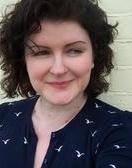Hello and it's that time again! For Blogvent this year I will be throwing a load of lady artists at you because they really need to get out more. I will be seeing how much I can find out in 24 hours and then fling it in your general direction, no doubt shouting 'hurrah!' because it's Christmas and quite honestly, I need to get out more too. By the end of this Blogvent, we should have met 24 more ladies and admired at least one gorgeous image from them. That's the general idea, let's see how we go...

A Portrait of a Mother and Her Two Sons (1911)
First up is Hilda Fearon, who is at least fortunate enough to have a Wikipedia page, so they aren't 'unknown' (okay, first digression of the season, I absolutely cringe when historians say they 'discover' a painter or an artwork. No you didn't, it was always hanging on someone's wall or in a store. You can raise awareness or shine a bit more light on things, but you no more discovered it than Columbus discovered America. It was always there, you just hadn't looked yet. Anyway, on with Hilda...)
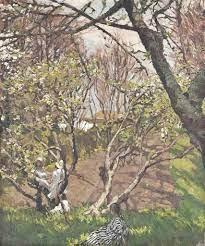
Springtime (1914)
Miss Fearon was born in 1878, the third daughter of wine merchant Paul (1849-1929) and his wife Edith (1851-1922). Paul and Edith married in 1875, welcoming daughter Edith junior in 1876, then Annie in 1877. After Hilda, came only son Paul in 1880 and finally Ethel in 1882. The family were nicely off, living in Court House in Banstead, Surrey with 5 servants (you know how servant obsessed I am). I especially like the fact that on September 14th 1888, Paul and Edith got all the kids baptised at once in Swanage (which is a very nice place to get baptised). I wonder if they got a group rate? Anyway, being a wealthy family, Ancestry is actually not much help in figuring out someone's life as our Hilda is a woman of no occupation until she moves out of her home in the 1911 census, then magically she becomes an Artist! However, we obviously are aware of her artistic career, thanks to the newspapers and the Royal Academy catalogues. Thanks to the Cornwall Artists Index we have a very good idea of her education, moving from an interest at school to the Slade, then to Robert Sterl in Dresden and finally under Algernon Talmage at St Ives. Now, I'm far too classy to make any sort of joke about what she learned under Algernon Talmage, but the couple did end up living together towards the end of her life.
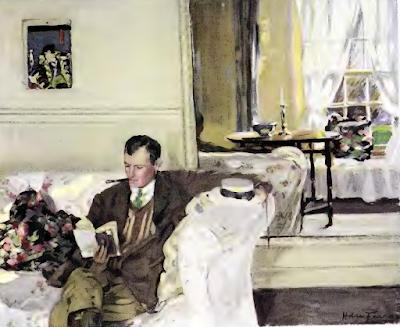
Portrait of Algernon Talmage (1914-15)
Annie Fearon was also a painter and an embroiderer and she and Hilda studied together at the Chelsea School of Art, then the Slade, moving together to Dresden between 1897 to 1899, then to Cornwall. Annie married the Reverend Bernard Walke, curate of St Ives. Hilda developed her British Impressionist manner of painting, which is evident in works such as Figures in a Field or, possibly most famously, The Tea Party which was given to the Tate by Talmage after Hilda's death...
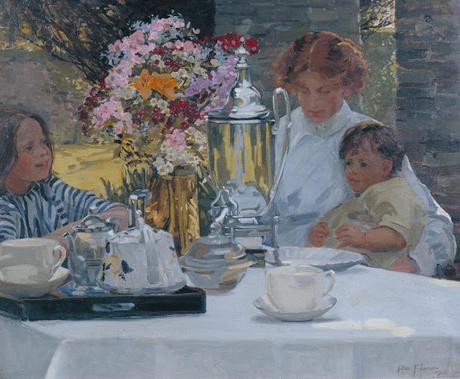
The Tea Party (1916)
While reading about Hilda today I was very much reminded of Isobel Gloag, not least because their careers seem to take a similar brief trajectory, but also because Hilda had a piece written about her in The International Studio as well, in 1914, where Charles Marriott made a very interesting observation about her work. He stated that her work, which tended towards figures in an interior (definitely after her move to London), were 'a little frosty in their manner' due to the lack of relationship between the figures. Each figure was perfectly realised in identity but how they responded to or felt about the other people in the image was a mystery. Marriott's answer to this is very interesting - 'The reason might be lack of sensibility or unusual reserve or coldness of temperament in the painter, but it is probably nothing more than the fact that she is a woman. This sounds like a paradox, because women are generally warmer and more intimate than men in their reactions to life.' I'm not sure how I feel about this statement, although I did snigger a bit, for which I apologize to Mr Marriott who I will return to again due to his amazing thoughts on lady painters. He continues to explain that painters go through three phases - the amateur who is all feeling and emotion, the student who is all technical and no emotion, and finally maturity, where they can marry together technique with proper levels of feeling. In the second phase, where Marriott firmly roots Hilda, it matters not whether the artist is a man or woman as they become sexless painting robots. He cites her 'masculine, or rather sexless' manner of execution in her work, but her evident growth was producing conception and outlook that was 'authentically feminine'. Apparently she did a painting of a Cornish farmhouse that was, and I quote, 'laughably bad' but she is better now.
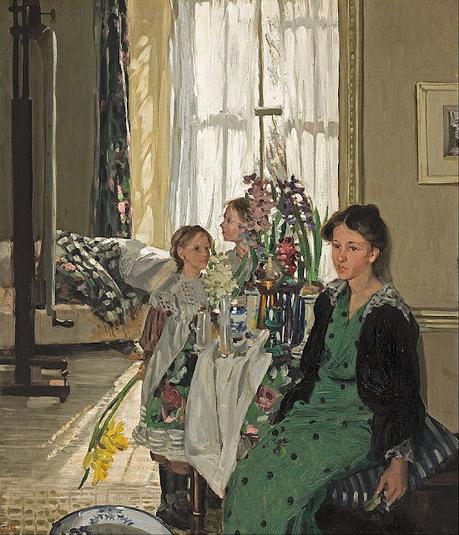
Studio Interior (1914)
Actually, looking at Studio Interior with its disconnected figures, Marriott might have a point. He did end the article on a very positive description of her art - 'one is conscious of the champagne air, the effervescent "hiss" of water, the feel - almost the smell - of newly laundered linen frocks...'
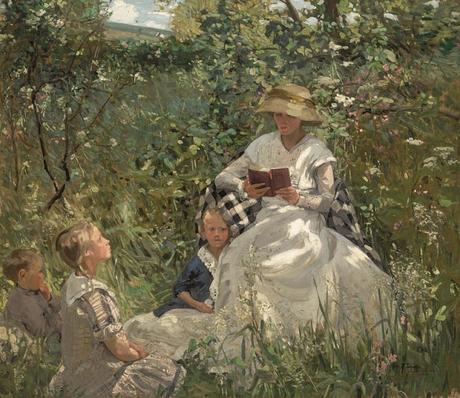
Enchantment (1914)
The problem with starting Blogvent with someone like Hilda is there is actually far more information and images available than I imagined so now I have a heap of notes and only today to get this done, but it raises a question - why is she not better known? I think actually this is a problem that affects all British Impressionists, who are smashing and yet not really box office yet. They are patently the successors to Turner so we shouldn't get hung up on the term 'Impressionists' because it makes it look like we had a go at an art movement after the fact and it wasn't bad just not as good as the original. They need a new movement name - how about Post-Turnerites? It could catch on. Sorry, back to Hilda...
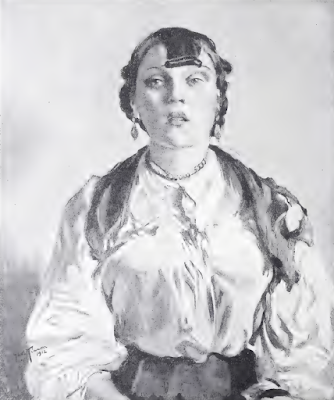
Alice (1916)
Hilda moved to London in around 1908, living at 68 Cathcart Studios, 44 Redcliffe Road (Alexa Wilding lived at 33 Redcliffe Road in the 1870s). She exhibited Willows at the Royal Academy in 1908, The White Room and The Sandpit in 1910 (the former was displayed close to Isobel Gloag's In the House of Simon the Pharisee). Hilda seems to have continued to fill the Royal Academy each May as in 1911 she exhibited The Window and The Morning Drive which were described by the Gentlewoman journal as 'fulfilling her promise of individual views ... impatient of prettiness and flattered color and set upon the larger beauties of atmospheric simplicity and bigness of effect.'
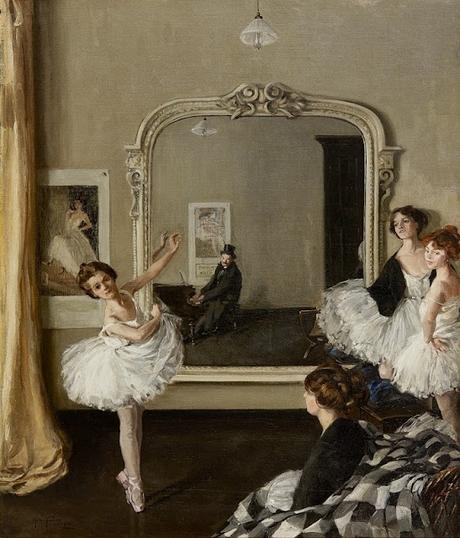
The Ballet Master (1912)
For the RA in 1912, she displayed The Window and The Ballet Master, a work that was compared with the ballet images of Renoir and won a special mention in the Paris Salon of 1913. This was followed in 1913 with three, yes three, paintings in the May exhibition, Midsummer (which was shown again in the 1915 RA War Relief exhibition), Under the Cliffs, which The Queen magazine called 'a triumph of technique, of assured rightness of tone rather than interest of colour', and Silver and Green (now in Minneapolis Institute of Art)...
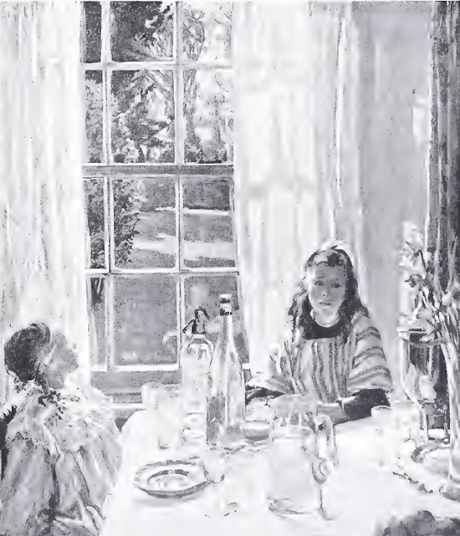
Silver and Green (1913)
In 1914, she seems to have taken it easy with only one painting exhibited at the RA, Enchantment. As I have said before, I love the RA catalogues as they also have the addresses of the artists in the back (should you wish to visit them in your time machines). Up until 1914 Hilda's address remained in Redcliffe Road, but for the 1915 exhibition, where she showed Spring Flowers and The Hayrick, she is listed c/o the framers J J Patrickson in Church Street, Chelsea. In 1916, when she exhibited The Breakfast Table and Nannie, Bessie and John, Hilda's address had changed to 22 Joubert Mansions, Jubilee Place in Chelsea. Although Algernon Talmage lists his RA address as the Chelsea Arts Club, it is widely written that by this point the couple were living together in Joubert Mansions.

Afternoon Sunshine (1917)
Hilda's paintings for the 1917 RA exhibition, Afternoon Sunshine and The Road Across the Downs were praised by the Gentlewoman journal, as they 'sustain this painters growing reputation.' Colour journal reported that Hilda was 'an artist whose work showed remarkable strength and decision' and the Sketch remarked that 'Miss Hilda Fearon exhibits things seen and felt,' surely the pinnacle of what Charles Marriott would call maturity in art. Sadly, less than a month later, on 2nd June 1917, Hilda died, aged only 39.
In Mrs Ethel Alec-Tweedie's fabulous 1918 book Women and Soldiers, Hilda gets an interesting name-check. When discussing how life had changed for women in the three years of the war, Mrs EAT states that things have moved more than in the previous three hundred, yet some things remain still unreachable:
'Forsooth, you may still be a Clara Montalba, a Laura Knight, a Henrietta Rae, a Lucy Kemp-Welsh, a Hilda Fearon or an Anna Airy, without the least danger of being raised to the heights upon which Royal Academicians giddily draw breath. Why look for a post on the line? There is plenty of wall space above and below. Artistic merit has its own reward, my dear lady, so aspire not to the alphabet.'
When I read that, I was amazed that only a few of those women are now widely known, and also at the mindset that it's nice to be invited to the party, you don't need any cake. I can't believe that given the opportunity, Laura Knight or Henrietta Rae wouldn't have loved to be the President of the RA but were just pleased to be brilliant painters who were allowed to exhibit with the men. Without getting too ranty, this is a bit of a touchstone for this advent, that these women and more like them, deserve to be considered for the line because they are extremely talented in a world that would rather they did something else, quietly.
Forsooth, Hilda Fearon and other female Post-Turnerites deserve our love. She was in a 1960 piece in the West Briton and Royal Cornwall Gazette on 'Art and the Artist in Cornwall' by Michael R L Canney, the curator of Newlyn Art Gallery. There needs to be a more enthusiastic embrace of this period in our art history, so I can smell a retrospective coming our way soon...
